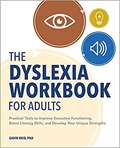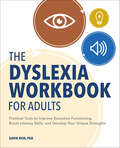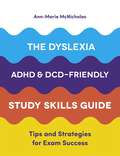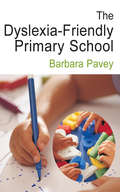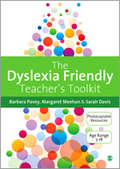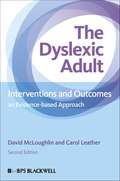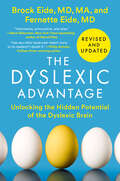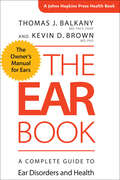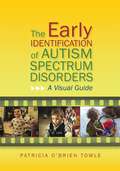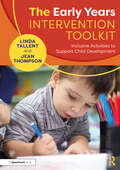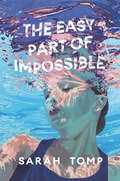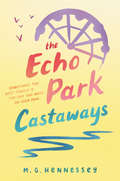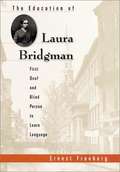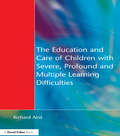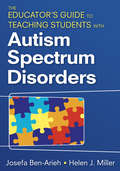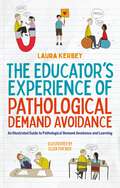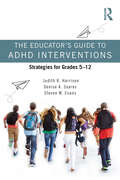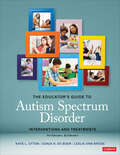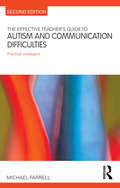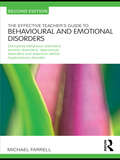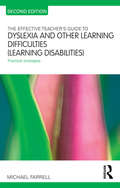- Table View
- List View
The Dyslexia Handbook: Procedures Concerning Dyslexia and Related Disorders
by Texas Education AgencyThe Texas Education Agency (TEA) handbook contains the SBOE-approved procedures concerning dyslexia and related disorders. It provides guidelines for school districts to follow as they identify and provide services for students with dyslexia. Additionally, the handbook provides school districts and parents/guardians with information regarding the state's dyslexia statutes and their relation to these federal laws.
The Dyslexia Handbook: Procedures Concerning Dyslexia and Related Disorders (Revised #2014)
by The Editors at the Texas Education AgencyThe handbook contains the SBOE-approved procedures concerning dyslexia and related disorders.It also provides guidelines for school districts to follow as they identify and provide services for students with dyslexia.
The Dyslexia Workbook for Adults: Practical Tools to Improve Executive Functioning, Boost Literacy Skills, and Develop Your Unique Strengths
by Gavin ReidImprove your skills and discover the strengths of your dyslexia―strategies and exercises for adults <P><P> Dyslexia is a continuous, lifelong journey―one that asks you to adapt and grow every day. The Dyslexia Workbook for Adults offers practical tools, techniques, and activities to help you improve your literacy skills, boost your self-esteem, and use your dyslexia as an advantage. <P><P> Gain a sense of empowerment and a greater appreciation for the positive aspects of dyslexia with exercises designed to develop the strengths unique to dyslexic patterns of thinking. Explore specific strategies for targeting problems that adults with dyslexia experience with spelling, reading, writing, memorization, organization, and other executive functioning skills. You’ll come to see your dyslexia as a gift and an important part of you. <P><P> The Dyslexia Workbook for Adults includes: Intro to dyslexia―Learn more about dyslexia and how it impacts adults, and take an assessment of your own experience with the characteristics of dyslexia. Coping strategies―Build resilience to dyslexia-specific stressors in your personal life and the workplace with actionable coping techniques. Dyslexia in action―Read real-life scenarios that depict people with dyslexia using a variety of strategies and employing their strengths to overcome challenges and thrive. Build greater confidence and stronger literacy skills with evidence-based tools and exercises for adults with dyslexia.
The Dyslexia Workbook for Adults: Practical Tools to Improve Executive Functioning, Boost Literacy Skills, and Develop Your Unique Strengths
by Gavin ReidImprove your skills and discover the strengths of your dyslexia—strategies and exercises for adultsDyslexia is a continuous, lifelong journey—one that asks you to adapt and grow every day. The Dyslexia Workbook for Adults offers practical tools, techniques, and activities to help you improve your literacy skills, boost your self-esteem, and use your dyslexia as an advantage.Gain a sense of empowerment and a greater appreciation for the positive aspects of dyslexia with exercises designed to develop the strengths unique to dyslexic patterns of thinking. Explore specific strategies for targeting problems that adults with dyslexia experience with spelling, reading, writing, memorization, organization, and other executive functioning skills. You'll come to see your dyslexia as a gift and an important part of you.The Dyslexia Workbook for Adults includes:Intro to dyslexia—Learn more about dyslexia and how it impacts adults, and take an assessment of your own experience with the characteristics of dyslexia.Coping strategies—Build resilience to dyslexia-specific stressors in your personal life and the workplace with actionable coping techniques.Dyslexia in action—Read real-life scenarios that depict people with dyslexia using a variety of strategies and employing their strengths to overcome challenges and thrive.Build greater confidence and stronger literacy skills with evidence-based tools and exercises for adults with dyslexia.
The Dyslexia, ADHD, and DCD-Friendly Study Skills Guide: Tips and Strategies for Exam Success
by Ann-Marie McNicholasThis practical skills guide helps young people with who learn differently including those with dyslexia, DCD/dyspraxia and ADHD, study for their exams.Students who learn differently can often find exams challenging and can experience a good deal of anxiety around exam time, leading to exam results that may not accurately reflect their capabilities. Much exam stress arises from a lack of confidence with the ability to learn and retain information in a meaningful way. This engaging workbook is designed to help students to overcome these issues. It not only shows students how to develop a positive success attitude towards study and exams, but also aims to equip them with powerful strategies and techniques for learning and remembering. The book offers strategies for learners whose methods of learning are multisensory. When learning is active rather than passive, it happens faster, and is easier, more enjoyable and more effective. As you progress through the fun, engaging activities, so your confidence and belief in your ability to learn will increase. Struggling students will become confident, successful learners, with a positive attitude and access to a wide range of effective strategies, and in this way, you will achieve the results in exams that you have worked for and deserve.
The Dyslexia-Friendly Primary School: A Practical Guide for Teachers
by Barbara PaveyIs your school dyslexia-friendly? Beginning with a look at understanding dyslexia, this book shows you how to involve the whole school in order to achieve a dyslexia-friendly environment. You will be able to: - use an audit tool to discover how dyslexia-friendly your school is - look at examples of successful dyslexia-friendly initiatives - find information on funding and resources. This book offers a step-by-step guide to creating a dyslexia-friendly classroom and whole-school environment. Headteachers, deputy headteachers, class teachers, SENCOs, student teachers and literacy co-ordinators wanting to make their school more dyslexia-friendly will find this practical book extremely useful. Barbara Pavey worked as a teacher and SEN specialist for many years and is now Lecturer in Learning Disabilities at The University of Manchester.
The Dyslexia-Friendly Teacher's Toolkit: Strategies for Teaching Students 3-18
by Barbara Pavey Margaret Meehan Sarah Davis'This book is a really practical, hands-on guide packed woth a wealth of advice on strategies and "things to try" reflecting the authors' extensive experience. If you want to make effective, inclusive dyslexia-friendly classrooms a reality rather than an aspiration, this book is for you'-Dr John P. Rack, Head of Research and Development, Dyslexia Action In this toolkit the authors provide you with the foundations for making your setting and your teaching style dyslexia-friendly. There is a general overview of the principles and practices required, and what the dyslexia-aware teacher needs to bear in mind. Chapters cover: - understanding learners with dyslexia; - dyslexia and phonics; - dyslexia and English as an Additional Language; - dyslexia and mathematics; - dyslexia and science; - dyslexia and creativity. Each chapter includes visual chapter overviews, tried and tested strategies for the classroom and the whole school, using technology to help learners, case studies from practice, children's voices and sources of further information. The book offers you ideas and advice, and will ensure you feel confident you are doing the right things to help overcome barriers to learning. Barbara Pavey is a lecturer in Higher Education, training dyslexia specialists in the North of England. Margaret Meehan is Coordinator of Specialist Tuition at Swansea University Sarah Davis is an Early Years Leading Teacher working in North Yorkshire
The Dyslexic Adult
by Carol Leather David McloughlinA definitive and evidence-based guide for psychologists, teachers, coaches, HR personnel and all professionals who must understand and work with dyslexic adults.The only book to look at dyslexia within the context of life span developmental psychology, including the factors that contribute to success - now fully revised and updatedCombines an accessible style with a strong focus on evidence-based practice and a sound theoretical model on which to base assessment, counselling, teaching and trainingProvides a clear guide to the kinds of assessment that can be conducted and the ways in which dyslexic adults can be supported in selection, training, education and employmentIncludes coverage of overlapping syndromes such as dyspraxia and dyscalculia, and up-to-date check lists for syndromes that can be used as part of the assessment process
The Dyslexic Advantage (Revised and Updated): Unlocking the Hidden Potential of the Dyslexic Brain
by Brock L. Eide Fernette F. EideAn updated edition of Drs. Brock and Fernette Eide's popular dyslexia book with a wealth of new material and improved dyslexic-friendly font. What if we viewed dyslexia as a learning and processing style rather than as a learning disorder? Drs. Brock and Fernette Eide use their impressive backgrounds in neurology and education to debunk the standard deficit-based approach to dyslexia. People typically define &“dyslexia&” as a reading and spelling disorder. But through published research studies, clinical observations, and interviews with dyslexic individuals, the Eides prove that these challenges are not dyslexia&’s main features but are instead trade-offs resulting from an entirely different pattern of brain organization and information processing that has powerful advantages. For example, dyslexic adults routinely outperform their non-dyslexic peers in studies on three-dimensional spatial reasoning and divergent creativity—one of the reasons why so many dyslexics are successful engineers. Approximately 20 percent of the U.S. population has dyslexia, and The Dyslexic Advantage shows how each one is predisposed to powerful skills called MIND strengths (Material, Interconnected, Narrative, and Dynamic Reasoning), leading them to possess incredible pattern detection, divergent thinking, episodic memory, problem solving, and prediction abilities. The revised and updated edition of The Dyslexic Advantage includes eighteen rich new profiles of remarkable individuals with dyslexia—such as several world-renowned scientists, a Pulitzer Prize–winning poet, a world-record-setting memory specialist, three MacArthur &“Genius&” Award winners, the technical advisor for the Jurassic Park movies, and many more. Meanwhile, the enormous advances in dyslexia research over the last ten years provide valuable new insights for educators, employers, parents, dyslexic adults, and anyone interested in neurodiversity and human cognition. Blending personal stories with hard science, The Dyslexic Advantage (Revised and Updated) provides empowering advice on how to identify, understand, nurture, and enjoy the strengths of the dyslexic mind.
The Ear Book: A Complete Guide to Ear Disorders and Health (A Johns Hopkins Press Health)
by Thomas J. Balkany Kevin D. Brown“Everything you ever wanted to know about ears from two outstanding physician scientists. I loved this book!” —Donna Shalala, Former U.S. Secretary of Health and Human ServicesIn The Ear Book, Drs. Thomas J. Balkany and Kevin D. Brown, recognized experts on ears and hearing, explain how the anatomy of the ear facilitates hearing and balance and then examine the causes, symptoms, and treatment of common problems of the outer, middle, and inner ear. Their explanations take the mystery out of hearing aids, the proper care of ears, and how the pressurized conditions of scuba diving and air travel affect the ears. And they debunk ear-related myths—from the notion that exposure to loud noise strengthens the ear to the idea that tinnitus can be cured with nutrients—and urge readers to stop using ear candling or Q-tips to get rid of wax.Drs. Balkany and Brown address such common questions as: Can dizziness be cured? How loud is too loud? Why do my ears ring? Do cochlear implants work for nerve deafness? What promise do innovations in gene therapy and stem cell therapy hold for the future? Fully illustrated and including helpful tables, hearing preservation tips, a glossary of terms, lists of ear medications and resources, and suggestions for further reading, The Ear Book is sure to be a welcome family guide.“This book is gem for everyone with questions about their ears. I highly recommend it—especially the chapter on Myths of the Ear!” —D. Bradley Welling, MD, PhD, Harvard University Department of Otolaryngology
The Early Identification of Autism Spectrum Disorders: A Visual Guide
by Patricia O'Brien TowleIdentifying Autism Spectrum Disorder (ASD) as early as possible can have a significant, positive impact on the child's journey to adaptation and independence. Yet too few diagnoses take place at an early, developmentally crucial stage. This unique visual guide aims to equip readers with the skills to recognise ASD in very young children. The book provides a systematic framework for understanding the complex nature of ASD. From social interaction to communication to restricted and repetitive behaviors, each chapter focuses on key symptoms and uses photographs to illustrate and enhance understanding of presenting or absent behaviors. It is written in an accessible style and covers all of the core aspects of ASD, giving readers everything they need to be able to successfully identify the behavioral indicators of autism. A final chapter provides an overview of assessment options for young children being evaluated for possible ASD. Taking a visual approach to identifying ASD in very young children, this book will be a valuable resource for early intervention professionals and students, occupational therapists, speech and language therapists, psychologists, paediatricians, teachers as well as parents of children pre- and post-diagnosis.
The Early Years Intervention Toolkit: Inclusive Activities to Support Child Development
by Jean Thompson Linda TallentThe Early Years Intervention Toolkit provides a range of ready-made activities to enable early years practitioners and health visitors to address observed difficulties in a child’s development prior to starting school. It includes a checklist of observed behaviours which links to a range of effective and engaging activities to support children’s development across the three prime foundational areas of learning: Communication and Language; Physical Development; and Personal, Social and Emotional Development. Activities focus on a variety of crucial skills such as speaking and listening, moving and handling, and forming relationships, making use of materials that are readily available in every early years setting. This toolkit offers: A time-saving approach to interventions, with additional guidance on planning, providing, and recording appropriate interventions Advice and activities to share with parents for them to try at home A framework to enable early years practitioners to identify specific difficulties in key areas of development Downloadable resources to support activities and interventions The Early Years Intervention Toolkit is an inclusive programme and all children in the early years will benefit from taking part in the activities. It will be an essential resource for early years practitioners to effectively identify and support learning needs in child development and will boost the confidence of young children as they prepare for Key Stage One.
The Easy Part of Impossible
by Sarah TompAfter an injury forces Ria off the diving team, an unexpected friendship with Cotton, a guy on the autism spectrum, helps her come to terms with the abusive relationship she’s been in with her former coach.Ria Williams was an elite diver on track for the Olympics. As someone who struggled in school, largely due to her ADHD, diving was the one place Ria could shine.But while her parents were focused on the trophies, no one noticed how Coach Benny’s strict rules and punishments controlled every aspect of Ria’s life. The harder he was on her, the sharper her focus. The bigger the bruise, the better the dive.Until a freak accident at a meet changes everything. Just like that, Ria is handed back her life, free of Benny. To fill her now empty and aimless days, Ria rekindles a friendship with Cotton, a guy she used to know back in elementary school. With Cotton, she’s able to open up about what Benny would do to her, and through Cotton’s eyes, Ria is able to see it for what it was: abuse.Then Benny returns, offering Ria a second chance with a life-changing diving opportunity. But it’s not hers alone—Benny’s coaching comes with it. The thought of being back under his control seems impossible to bear, but so does walking away. How do you separate the impossible from possible when the one thing you love is so tangled up in the thing you fear most?
The Echo Park Castaways
by M. HennesseyFrom the author of The Other Boy comes a poignant and heartfelt novel that explores what it means to be a family. Perfect for fans of Counting by 7s. <P><P>Nevaeh, Vic, and Mara are veterans of the Los Angeles foster care system. For over a year they’ve been staying with Mrs. K in Echo Park. Vic spends most of his time living in a dream world, Mara barely speaks, and Nevaeh is forced to act as a back-up parent. Though their situation isn’t ideal, it’s still their best home yet. <P><P>Then Child Protective Services places Quentin in the house, and everything is turned upside down. Nevaeh really can’t handle watching over anyone else, especially a boy on the autism spectrum. Meanwhile, Quentin is having trouble adjusting and attempts to run away. <P><P>So when Vic realizes Quentin just wants to see his mom again, he plans an “epic quest” to reunite them. It could result in the foster siblings getting sent to different group homes. But isn’t family always worth the risk?
The Education Of Laura Bridgman: First Deaf And Blind Person To Learn Language
by Ernest FreebergIn the mid-nineteenth century, Laura Bridgman, a young child from New Hampshire, became one of the most famous women in the world. Philosophers, theologians, and educators hailed her as a miracle, and a vast public followed the intimate details of her life with rapt attention. This girl, all but forgotten today, was the first deaf and blind person ever to learn language. Laura's dark and silent life was transformed when she became the star pupil of the educational crusader Dr. Samuel Gridley Howe. Against the backdrop of an antebellum Boston seething with debates about human nature, programs of moral and educational reform, and battles between conservative and liberal Christians, Freeberg tells this extraordinary tale of mentor and student, scientist and experiment. Under Howe's constant tutelage, Laura voraciously absorbed the world around her, learning to communicate through finger language, as well as to write with confidence. Her remarkable breakthroughs vindicated Howe's faith in the power of education to overcome the most terrible of disabilities. In Howe's hands, Laura's education became an experiment that he hoped would prove his own controversial ideas about the body, mind, and soul. Poignant and hopeful, The Education of Laura Bridgman is both a success story of how a sightless and soundless girl gained contact with an ever-widening world, and also a cautionary tale about the way moral crusades and scientific progress can compromise each other. Anticipating the life of Helen Keller a half-century later, Laura's is a pioneering story of the journey from isolation to accomplishment, as well as a window onto what it means to be human under the most trying conditions.
The Education and Care of Children with Severe, Profound and Multiple Learning Disabilities: Musical Activities to Develop Basic Skills
by Richard AirdThis is a practical guide to managing the whole curriculum for children with severe learning difficulties (SLD). Crucial guidance and effective strategies are provided on how to reconcile the rights, needs and aspirations of such children in light of recent national trends and QCA guidelines.
The Educator's Guide to Teaching Students With Autism Spectrum Disorders
by Josefa Ben-Arieh Helen J. MillerUse this guide to identify students with ASD, organize the classroom; manage time; promote independence, communication, and appropriate behaviors; and select visual strategies, tools, and curriculum resources.
The Educator’s Experience of Pathological Demand Avoidance: An Illustrated Guide to Pathological Demand Avoidance and Learning
by Laura KerbeyI realised EVERYTHING I was doing was wrong.I needed to learn.I needed to change.During Laura Kerbey's time teaching autistic children, she had a sudden realisation that those with Pathological Demand Avoidance (PDA) are children like no other! None of her tried and tested autism strategies would work to help them focus or learn and most of her time was spent wondering, what am I doing wrong?If you feel the same, this short, easy-to-read guide is here to teach you everything you need to know from one educator to another. With an introduction to what PDA is followed by PDA tailored advice on how to connect with your student and create an autonomous, spontaneous environment that is personalised for you both, this guide is here to ensure that you and your PDA student thrive!Illustrated by the popular Eliza Fricker and packed with entertaining anecdotes (including one about Jabba the Hut's poo), this go-to-guide contains everything you need to start implementing PDA friendly learning to help you connect with your student and help them make the most of their learning experience.
The Educator’s Guide to ADHD Interventions: Strategies for Grades 5-12
by Judith R. Harrison Steven W. Evans Denise A. SoaresDesigned specifically for middle and high school educators, this guidebook clearly and thoroughly breaks down effective classroom-based interventions for students with ADHD. Chapters walk readers through each intervention, providing step-by-step implementation guides, describing potential pitfalls and offering critical tips and advice to help you ensure that your interventions are both culturally responsive and sustainable. Filled with helpful templates and tools, this book is essential reading for anyone who needs help creating effective, sustainable interventions for students with ADHD.
The Educator′s Guide to Autism Spectrum Disorder: Interventions and Treatments
by Kaye L. Otten Sonja R. de Boer Leslie Ann BrossIdentify the best interventions to fit the unique needs of each learner with autism Whatever your role—general or special education teacher, school counselor, therapist, behavior analyst, administrator—you undoubtedly interact with learners with autism spectrum disorder (ASD) and are committed to helping them succeed and thrive. This easy-to-use accessible guide summarizes more than 75 interventions and rates each based on the most recent evidence of effectiveness and safety. Features include: A summary of interventions and treatments from a comprehensive variety of domains organized into 11 categories, including behavioral interventions, visual supports, social and emotional skills training, and physiological interventions, as well as interventions that have the potential for causing harm An evidence-based five-point scale that clearly rates each intervention’s effectiveness for specific learners Guidance for working with colleagues and families to choose and implement the most promising treatments Written by educators with decades of experience and expertise in a variety of settings, many of whom are also Board Certified Behavior Analysts, this comprehensive guide is an indispensable resource for all those who serve students with ASD.
The Educator′s Guide to Autism Spectrum Disorder: Interventions and Treatments
by Kaye L. Otten Sonja R. de Boer Leslie Ann BrossIdentify the best interventions to fit the unique needs of each learner with autism Whatever your role—general or special education teacher, school counselor, therapist, behavior analyst, administrator—you undoubtedly interact with learners with autism spectrum disorder (ASD) and are committed to helping them succeed and thrive. This easy-to-use accessible guide summarizes more than 75 interventions and rates each based on the most recent evidence of effectiveness and safety. Features include: A summary of interventions and treatments from a comprehensive variety of domains organized into 11 categories, including behavioral interventions, visual supports, social and emotional skills training, and physiological interventions, as well as interventions that have the potential for causing harm An evidence-based five-point scale that clearly rates each intervention’s effectiveness for specific learners Guidance for working with colleagues and families to choose and implement the most promising treatments Written by educators with decades of experience and expertise in a variety of settings, many of whom are also Board Certified Behavior Analysts, this comprehensive guide is an indispensable resource for all those who serve students with ASD.
The Effective Teacher's Guide to Autism and Communication Difficulties: Practical strategies (The\effective Teacher's Guides)
by Michael FarrellIn this welcome second edition of The Effective Teacher‘s Guide to Autism and Communication Difficulties, best-selling author Michael Farrell addresses how teachers and others can develop provision for students with autism and students that have difficulties with speech, grammar, meaning, use of language and comprehension. Updated and expanded, thi
The Effective Teacher's Guide to Behavioural and Emotional Disorders: Disruptive Behaviour Disorders, Anxiety Disorders, Depressive Disorders, and Attention Deficit Hyperactivity Disorder (The Effective Teacher's Guides)
by Michael Farrell'Michael Farrell offers well sourced overviews of the conflicting and contradictory advice that is available to schools, suggests a variety of solutions to challenges, empowering the reader to make their own choices.' - Carol Smart, Special Needs Information Press Fully updated with the latest research and advice on best practice, this new edition of The Effective Teacher’s Guide to Behavioural and Emotional Disorders covers a range of conditions that cause learning difficulties for children, including disruptive behaviour, attention deficit hyperactivity disorder, anxiety and depressive disorders. The theoretical underpinning is fully updated but also condensed in this edition to make way for more practical strategies for teachers. Teachers are likely to meet children with varying types and degrees of emotional behavioural disorders. This comprehensive guide equips you with informed and practical strategies to ensure that all pupils are included and provided for in the best possible way. The new edition has also been adapted to be more widely relevant to readers in different countries, focusing more on the strategies that work regardless of national context. Writing in his popular accessible style, Michael Farrell suggests the best ways of dealing with a variety of conditions, always with practical classroom situations in mind. In each section, the book: sets out the definitions of the condition looks at the range of provision suggests intervention and support strategies gives points for reflection and suggested further reading. Highly accessible and authoritative, this book provides teachers with an invaluable resource to help you create a truly inclusive classroom.
The Effective Teacher's Guide to Dyslexia and other Learning Difficulties: Practical strategies (The Effective Teacher's Guides)
by Michael FarrellThis highly anticipated second edition of The Effective Teacher's Guide to Dyslexia and other Learning Difficulties (Learning Disabilities) critically examines the specificity and complexity of learning disabilities. The user-friendly text highlights the importance of schools reviewing their curricula and assessment, pedagogical methods, resources, organisation and therapy procedures to ensure that their provision helps encourage academic progress and the best personal and social development for their pupils. This book accessibly and authoritatively addresses a range of issues associated with: Reading disorders / dyslexia Disorder of written expression/ dysgraphia Developmental co-ordination disorder/ dyspraxia Mathematics disorder/ dyscalculia. Offering what works in the classroom, this text also takes into account the relationship between professionals who work closely with parents and other professionals. It helpfully recognises the importance of professional contributions and the foundational disciplines that contribute to special education. Underpinned by research and widely held professional opinions, this second edition of The Effective Teacher's Guide to Dyslexia and other Learning Difficulties (Learning Disabilities) will prove a practical, readable and invaluable resource for the busy teacher, students on initial teacher training courses, school managers and administrators.
The Effective Teacher's Guide to Moderate, Severe and Profound Learning Difficulties: Practical strategies (The Effective Teacher's Guides)
by Michael FarrellThis updated second edition of The Effective Teachers Guide to Moderate, Severe and Profound Learning Difficulties (Cognitive Impairments) has been restructured and expanded to ensure it continues to meet the needs of the busy teacher. This new edition is highly relevant and contextualized, drawing on the curriculum and assessment, pedagogy, resources, therapy and care and school and classroom organisation. It is accessible and practical in approach yet offers the necessary underpinning of research and professional knowledge to enable the teacher to be self-critical in developing classroom approaches. The book accessibly and thoroughly discusses the classroom difficulties associated with: Mild cognitive impairment Moderate to severe cognitive impairment Profound cognitive impairment Conditions associated with cognitive impairment. A much needed source of knowledge for teachers, students on initial teacher training courses, school managers, and administrators, this book will be of interest to anyone who supports children and young people with cognitive impairments.

